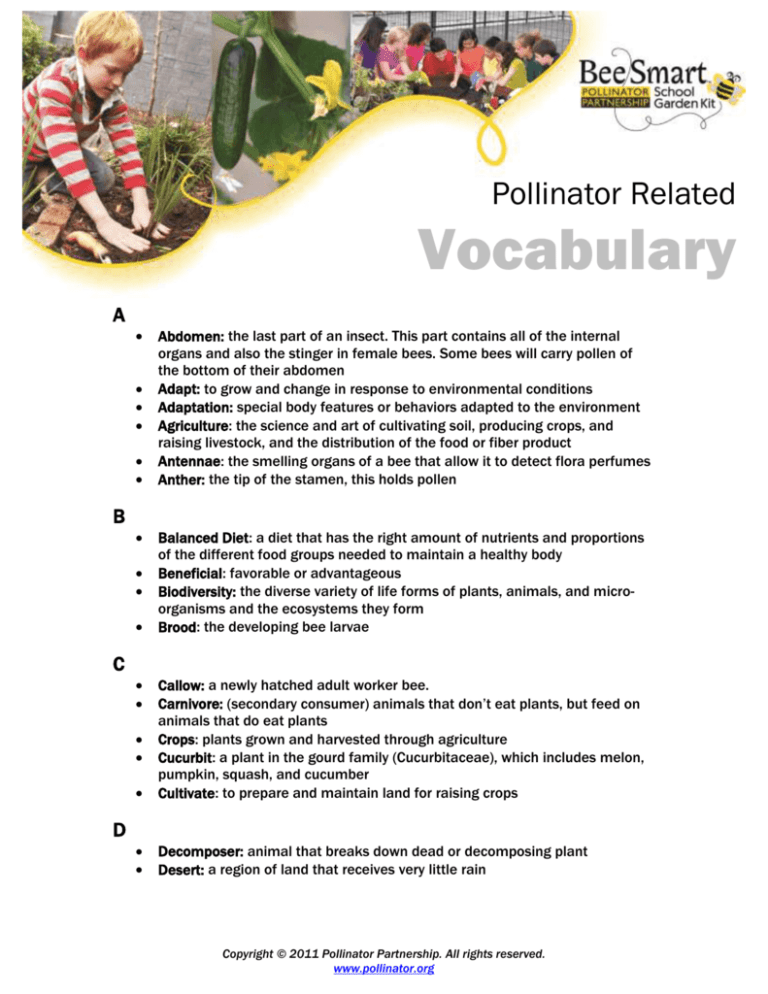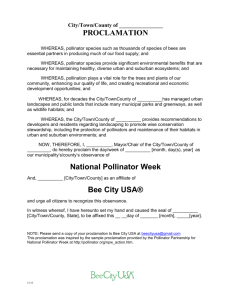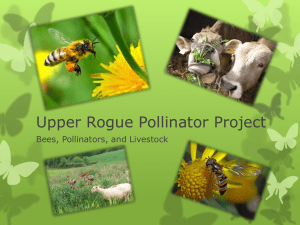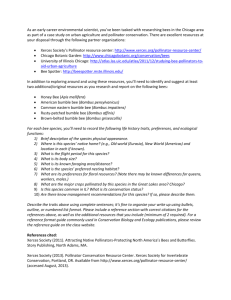
Page 1
Pollinator Related
Vocabulary
Pollinator Related
Vocabulary
A
Abdomen: the last part of an insect. This part contains all of the internal
organs and also the stinger in female bees. Some bees will carry pollen of
the bottom of their abdomen
Adapt: to grow and change in response to environmental conditions
Adaptation: special body features or behaviors adapted to the environment
Agriculture: the science and art of cultivating soil, producing crops, and
raising livestock, and the distribution of the food or fiber product
Antennae: the smelling organs of a bee that allow it to detect flora perfumes
Anther: the tip of the stamen, this holds pollen
B
Balanced Diet: a diet that has the right amount of nutrients and proportions
of the different food groups needed to maintain a healthy body
Beneficial: favorable or advantageous
Biodiversity: the diverse variety of life forms of plants, animals, and microorganisms and the ecosystems they form
Brood: the developing bee larvae
C
Callow: a newly hatched adult worker bee.
Carnivore: (secondary consumer) animals that don’t eat plants, but feed on
animals that do eat plants
Crops: plants grown and harvested through agriculture
Cucurbit: a plant in the gourd family (Cucurbitaceae), which includes melon,
pumpkin, squash, and cucumber
Cultivate: to prepare and maintain land for raising crops
Decomposer: animal that breaks down dead or decomposing plant
Desert: a region of land that receives very little rain
D
Copyright © 2011 Pollinator Partnership. All rights reserved.
www.pollinator.org
Page 2
Pollinator Related
Vocabulary
Drone: the male bees produced by the queen that do not work in the hive;
they eventually leave the hive to mate with other queen bees
Ecosystem: a community of living and non-living things that live and work
together
Egg: the first life stage of a bee
Embryo: earliest stage of plant development, comprised of tiny plant parts
that are contained within the outer seed coat
Endangered: animal or plant species in danger of extinction throughout all or
a significant portion of their range due loss of habitat, overexploitation,
competition or disease
Endosperm: fleshy part of a seed and the food source for the developing
embryo
Environment: complex web of inter-relationships between living organisms
and non-living components, which sustain all life on earth
Eyes: the part of the head bees use to see, all bees have 5
E
F
Fauna: all of the animals found in an area
Filament: the stalk that bears the stamen in a flower
Flora: all of the plants found in an area
Flower: reproductive structure of a plant
Food web: a group of interlinked food chains. Involves herbivores, omnivores,
carnivores, scavengers and decomposers, so that no available source of
energy is allowed to go to waste
Forage: a food resource that a bee feeds on, commonly pollen and nectar.
Forager: a worker whose job is to leave the hive and collect pollen and nectar
Forested: a region of land filled with many trees that has hot summers and
cold winters
Frost: when the temperature falls below freezing and small ice crystals form
on the ground and plants
Fruit: fleshy part of the plant that is often edible. It usually has seeds inside,
and is the result of a fertilized flower. Fruits develop from a ripened ovary
H
Habitat: a place that contains all the essential elements that an organism
needs to survive (food, water, shelter)
Harvest: the process of gathering crops
Head: the part of the insect that contains the eyes, antennae, and mouth
parts
Herbivore: (primary consumer) animals that eat primarily plants
Hive: a special type of nest build but a group of colonial social bees, such as
honey bees or bumble bees
Copyright © 2011 Pollinator Partnership. All rights reserved.
www.pollinator.org
Page 3
Pollinator Related
Vocabulary
L
Larvae: the second life stage of a bee
Leaf: the plant organ that specializes in photosynthesis (turning sunlight into
energy for the plant)
Legs: the appendages that bees and other insects use to walk
M
Metamorphosis: the process of change from young to adult
Migration: the seasonal, usually 2-way movement from habitat to another to
avoid unfavorable climatic conditions
Native: indigenous to and dwelling within a specific area for an entire
lifespan
Nectar: sweet liquid produced by plants, usually located in the flowers
Nest: the location where a bee lays an egg or series of eggs
Nurse: a worker whose job is to take care of the young larvae
Nutrients: essential vitamins and minerals that organisms get through
consuming food
N
O
Ovary: female part of the flower that holds the eggs for fertilization, and
where seeds develop
Petal: colorful flower parts that surround the floral reproductive structures
Photosynthesis: the process plants use to convert the sun’s energy into food
Pistil: female reproductive part of a flower that moves the pollen into the
ovule
Plains: a region of land that is flat
Plant: a living being that possessing cell walls and generally can produce it’s
own food or energy from photosynthesis
Pollen: yellowish, dust-like powder that carries the elements for the
fertilization of flower’s egg
Pollen basket: a flat and fuzzy part of a bee’s hind leg that is used to carry
pollen
Pollen tube: tube formed after germination of the pollen grain
Pollinated: a flower in which the female parts of a flower have received
pollen from the male parts of the same flower, or another flower
Pollination: when pollen of a flower are moved into contact with the female
reproductive parts of the same type of flower, resulting in fertilization
Pollinator: animal that carries pollen from the male parts of flowers to the
female parts, fertilizing plant “eggs” with plant “sperm”
P
Copyright © 2011 Pollinator Partnership. All rights reserved.
www.pollinator.org
Page 4
Pollinator Related
Vocabulary
Pollinator-dependent: plants that depend on animal pollinators to be
pollinated so they develop seeds and fruit
Primary consumer: an organism that obtains energy from primary producers
Primary producer: all food chains begin with green plants (“primary
producers”) with a process called photosynthesis. Energy from the sun lands
on plants and is collected by chlorophyll, with which plants make sugar and
oxygen, food for other animals
Proboscis: protruding mouthpart of an animal. In animals such as a bee or
butterfly, it is designed for drinking nectar
Pupae: the third life stage of a bee where the larvae transforms into an adult
Q
Queen: the largest bee in the hive and the mother of all of the bees in the
hive
Root: the part of the plant usually found below the soil. Plant roots absorbs
water and minerals from the soil, anchors the plant in place, and stores food
and nutrients
Scout: a worker whose job it is to find new sources of pollen and nectar for
the hive
Seasonal resources: food resources that are available at a specific time of
year
Secondary consumer: a consumer that obtains energy from other consumers
Seed coat: Protective outer layer of a seed, incasing the embryonic plant and
stored food
Seed: a reproductive structure containing a tiny plant with a store of food
and incased in a seed coat, formed after a flower has been pollinated.
Sepals: the green leaf-like parts of a flower that enclose the petals (often
found at the base of the petals)
Shelter: protection from weather, predators and other dangers; provides
warmth and light as needed
Social bee: a bee that lives in a colony or group of other bees within one nest
Soil: a natural substance composed of inorganic and organic material, water,
air, and living organisms, which supports plants, animals, and
microorganisms
Solitary bee: a bee that lives alone and works alone to make a nest
Solitary: an organism that lives alone
Sprout: the first parts of a young plant to immerge from the seed
Stamen: male reproductive part of a flower that holds and makes pollen
Stem: the main above ground structure of a plant that transports water and
minerals up and down the plant and to newly formed plant parts
R
S
Copyright © 2011 Pollinator Partnership. All rights reserved.
www.pollinator.org
Page 5
Pollinator Related
Vocabulary
Stigma: the top part of the pistil, which is often sticky in order to trap the
pollen
Style: the slender part of a flower’s pistil
Copyright © 2011 Pollinator Partnership. All rights reserved.
www.pollinator.org
Page 6
Pollinator Related
Vocabulary
T
Temperate: a region of land that has moderate temperatures, rather than
very hot or very cold
Thorax: the middle part of the insect where the wings and legs are attached
Threatened: species likely to become endangered within the foreseeable
future, without special protection and management efforts
Tropical: a region of land that only has dry periods or wet periods
Tundra: a very cold region of land that does not contain trees
Vegetable: non-woody plant or plant parts
Vine: a plant with thin stems that climbs along other structures
Wings: the appendages that bees and other insects use to fly
Worker: all of the female bees in the hive that are not the queen. Each
worker has a unique task associated with its age
V
W
Copyright © 2011 Pollinator Partnership. All rights reserved.
www.pollinator.org










